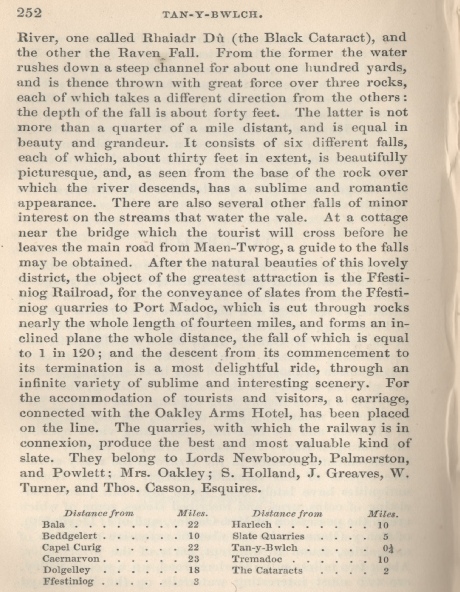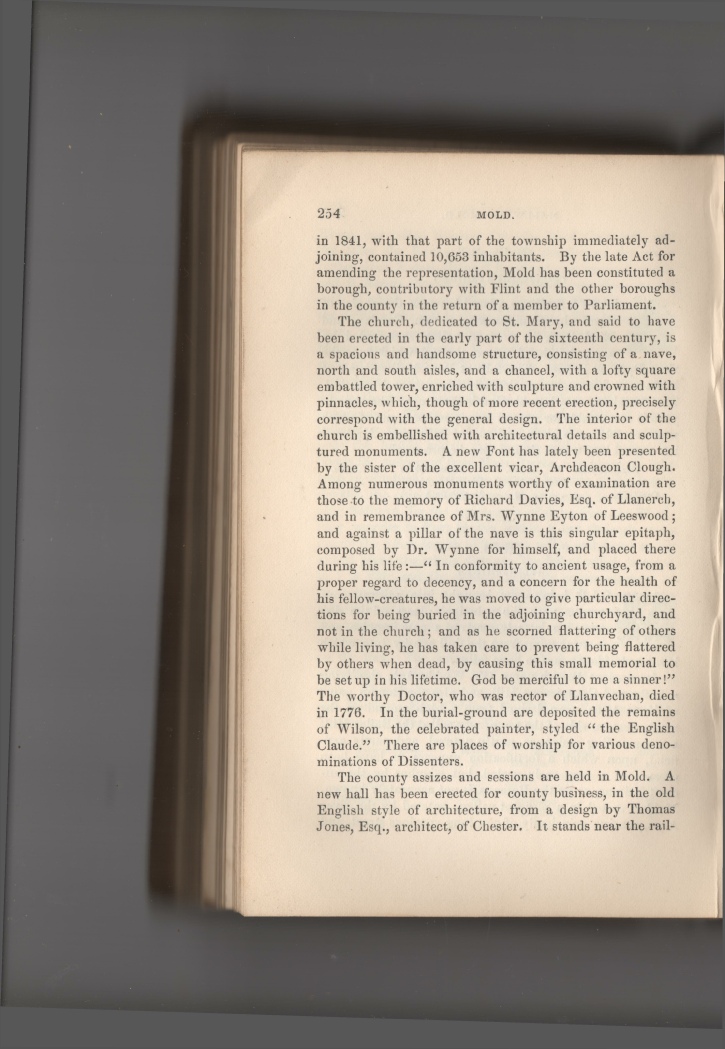MALLWYD MOLD. 253
Mallwyd
MONTGOMERYSHIRE
LITTLE village, placed between the angles of three abrupt mountains, Arran, Camlan , and Moel Dyfi, in a small valley surrounded by
many delightful scenes, through which runs the
river Dyfi, or Dovey.
The falls at Pont Mallwyd, about half a mile distant, are particularly romantic and beautiful.
The church is a very humble Gothic structure.
The churchyard is remarkable for several large yew trees, one of which measures 22 feet in girth, and 40 feet in height.
Mallwyd
has a good inn, where chaises may be procured.
Distance from M iles. Distance from M iles.
B a l a .......................................... 19 Dinas Mowddwy ....
Can-Office................................12 M a c h y n lleth ............................12
Mold
FLINTSHIRE.
O LD being now brought into railway connexion with the principal places of the district, has latterly received a new impulse, and
is awakening from the dull apathy into which
it seemed of late years to have fallen.
Its ancient British name (Yr Wyddgrug), signifying a Lofty and Conspicuous Hill, and also the Roman name of Mont Altus , were derived from a high mound on the
north-western side of the town, now called the Bailey Hill,
a commanding eminence, partly natural, and partly artificial, upon which a fortification appears to have been
erected at a very early period, but whether by the ancient Britons, or by the Romans, is not accurately known.
Mold is seated in a pleasant valley, watered by the river
Alyn, consists principally of one long spacious street, and


MOLD. 255
way station, from which a branch-line runs to form a junction with the Chester and Holyhead Railway , about a mile
below Saltney. The prin cip al inns are the B la ck L ion,
the L eesw ood A rm s, and the R oy a l O ak ; to the form er o f
w hich a spacious assem bly-room has lately been added,
and m any agreeable balls are there given . E xcellen t
schools have been established here ; and in M ay, 1850,
tw o new m arket-halls w ere opened fo r business. In the
environs are numerous seats and m ansions o f the ge n t r y ;
as w ell as various w orks for smelting lead, and an extensive cotton -mill, the latter of which is not at w ork.
The parish abounds with mineral w e a lth ; the western district is rich in lead ore, which is generally found imbedded in lim estone or chirtz ; but the operations are
much impeded b y the subterranean stream o f the A ly n , w hich here flow s under ground for the space of upw ards
o f h a lf a m ile. Numerous tumuli are found in various
parts o f the parish. In Octob er 1833, som e w ork m en
d igg in g in a field near the tow n, discovered a hum an
skeleton, having at its feet an earthen pot, w hich apparently contained ash es; and on the breast, w ith other
m etal, a large corslet o f g old , m uch ornamented, valued
at the sum o f 70l. : the trustees o f the British Museum became the purchasers of these antique relics.
O f the ancient castle not a vestige at present can be discerned, and its very site is com p letely covered with
thriving plantations. The Bailey h ill , on w hich it stood,
though at present difficult o f ascent, was rendered still more arduous b y the erection of strong ram parts and the
formation o f a deep m o a t: from the sum m it o f this hill a
fine view o f the surrounding cou n try is obtained. O n this
spot, in June 1849, fifteen skeletons w ere found w hile e x
cavating the ground for a b ow lin g -g reen . T h ey w ere those
o f m en w h o had eviden tly been laid in their graves after
the manner o f Christian bu ria l; and are supposed to have been the bodies o f soldiers w h o had fallen in battle, and were subsequently interred there, during the thirteenth
MOLD.
in 1841 , with that part of the township immediately adjoining , contained 10,653 inhabitants.
By the late Act for am ending the representation, Mold has been constituted a borough , contributory with Flint and the other boroughs in the county in the return of a member to Parliament.
The church, dedicated to St. Mary, and said to have been erected in the early part of the sixteenth century, is a spacious and handsome structure, consisting of a nave,
north and south aisles, and a chancel, w ith a lofty square embattled tower, enriched with sculpture and crowned with
pinnacles, w hich, though o f m ore recent erection, precisely
correspond with the general design. The interior o f the
church is em bellished w ith architectural details and sculptured m onum ents. A new F ont has lately been presented
b y the sister o f the excellen t vicar, A rch deacon C lou gh .
A m on g num erous m onum ents w orth y o f exam ination are
those to the m em ory o f R ich ard D avies, Esq. o f Llanerch,
and in rem em brance o f M rs. W y n n e E y ton o f L ee sw o o d ;
and against a p illa r o f the nave is this singular epitaph,
com posed b y D r. W yn n e for him self, and placed there
during his li f e :— “ In con form ity to ancient usage, from a
prop er regard to d ecen cy , and a concern for the health o f
his fellow -creatures, he was m oved to give particular d irections for bein g buried in the adjoining churchyard, and
not in the c h u r c h ; and as he scorned flattering o f others
w h ile living, he has taken care to prevent bein g flattered
b y others when dead, b y causing this sm all m em orial to
be set up in his lifetim e. G od be m erciful to m e a sin n er!”
T he w orth y D octo r, w ho was rector o f L lanvechan, died
in 1776. In the bu rial-grou nd are deposited the rem ains
o f W ilson , the celebrated painter, styled “ the English
Claude.” There are places o f w orship for various denom inations o f Dissenters.
The coun ty assizes and sessions are held in M old. A
new hall has been erected for coun ty business, in the old
E nglish style o f architecture, from a design b y Thom as
Jones, E sq., architect, o f Chester. It stands near the rail



Mold cape
From Wikipedia, the free encyclopedia
Jump to navigationJump to search
Mold cape
The Mold cape.jpg
The Mold cape in the British Museum
Material Gold
Created 1900–1600 BC
Discovered Mold, Wales in 1833
Present location British Museum
The Mold cape is a solid sheet-gold object dating from about 1900–1600 BC in the European Bronze Age. It was found at Mold in Flintshire, Wales, in 1833.
The cape is thought to have formed part of a ceremonial dress, perhaps with religious connections. It is housed at the British Museum in London.
Contents
1 Discovery
2 The cape
2.1 The decorative motifs
3 Parallels
4 Excavation and display
5 In popular culture
6 British Museum registration numbers
7 See also
8 Bibliography
9 References
10 External links
Discovery
The gold cape was found in 1833 by workmen (accounts vary: either during the filling of a gravel pit[1] or while they were quarrying for stone[2]).
The cape was within a Bronze Age burial mound in a field named Bryn yr Ellyllon, the Fairies' or Goblins' Hill. The gold cape had been placed on the body of a person who was interred in a rough cist (stone-lined grave) within a burial mound. The preserved remains of the skeleton were fragmentary, and the cape was badly crushed. An estimated 200–300 amber beads, in rows, were on the cape originally, but only a single bead survives at the British Museum. Also associated with the cape were remains of coarse cloth and 16 fragments of sheet bronze which are likely to have been the backing for the gold: in places the gold was riveted onto the bronze sheeting with bronze rivets. There also were two gold 'straps' among the artefacts found. An urn with large quantities of burnt bone and ash was 60–90 cm (24–35 in) from the grave.
The cape's breadth is 458 mm (18.0 in). It was designed to fit someone of a very slight build, and although the gender of the person buried in this grave remains unclear, the associated finds are likely, by comparison with similar contemporary graves discovered, to be those accompanying the burial of a woman.[3]
The cape
Mold Cape, British Museum
The cape is considered to be one of the most spectacular examples of prehistoric sheet-gold working yet discovered. It is of particular interest as both its form and its design are unparalleled. The cape is oval in shape and would cover the shoulders, upper arms, and upper chest of the person wearing it, being higher at the back and lower in the front.
The craftsmanship with which the cape was constructed is exceptional. The object was beaten out of a single ingot of gold, a task which would have taken considerable time and skill, and was then intensely decorated with repoussé concentric rings of ribs and bosses. The decoration almost totally fills the object's outer surface, so that very little "plain" gold remains. It has been suggested that this decorative motif may mimic multiple strings of beads and/or the folds of cloth.[2]
The value of the metal and the quality of the craftmanship suggests that the cape was produced by a wealthy culture. Scholars speculate that the makers and owners of the cape were associated with the mine on the Great Orme, north Wales, the largest copper mine in north-west Europe at that time.[4]
As the cape extends so far down the upper body, it would have severely restricted arm movement by pinning them to the wearer's side, so that only the lower arms were usable. For this reason, it has been concluded that the cape would not have been suitable for everyday wear. It seems most probable that the cape was used for ceremonial purposes, and may have signified the wearer as a person of spiritual or temporal power: the Bronze Age equivalent of a chasuble, perhaps.
The decorative motifs
Detailed image showing decoration bands and tool marks.
Around the neck and base is a line of perforations. There are three zones of decoration on the cape: a band running around the base, a curving panel that dips at the neck and rises over the shoulders, and two matching panels to fill in the upper arm area. Above the perforations at the base are two high ridges and a deep groove. Above the groove is a line of conical bosses that run around the whole cape, but bifurcate at the front to rise up over the triangular panels at the upper arm. The bosses at the front are enlarged.
At the front the sequence of decoration above the bosses is, from bottom to top: ridge, three rows of small domed bosses, ridge, row of square-based pyramids, ridge, row of small domed bosses, ridge, row of lentoid bosses, ridge, three rows of small domed bosses, ridge, row of conical bosses and finally, three ridges.
The back has the same sequence with the addition, from bottom to top, of ridge, row of lentoid bosses, ridge, three rows of small domed bosses, ridge and, a row of lentoid bosses.
The two triangular areas on the upper arm are bounded at the front by a ridge, row of lentoid bosses and a ridge. At the front and back it is then bounded by three rows of small domed bosses. Inside this is a ridge, a row of conical bosses, and two ridges with a groove. The central area is filled with small domed bosses. At the base of each ridge and the large bosses are fine punched indentations (pointillé). In places the perforations at the base are double. In areas where parts of the cape are missing there are perforations (possibly from a previous repair).
Perforations along the upper and lower edges may indicate that it was once attached to a lining, perhaps of leather, which has decayed. The bronze strips may have served to strengthen the adornment further.[5]
Parallels
The Wessex region of England during the Bronze Age was noted for the wealth of its grave goods, particularly the exquisite goldwork in up to 15% of its graves. Fifteen findspots of goldwork are known for Wessex, compared to five in four other southern English counties (Cornwall, Devon, Essex, and Norfolk) with an apparent complete absence in the rest of the country. It is thought that much of this Wessex goldwork was the product of a single master craftsman, and that all may have been a product of his workshop.[6] The Mold cape is the only other piece of Bronze Age goldwork that challenges the Wessex material in its richness; however, the decorative motifs employed in the cape are dissimilar to those found in the Wessex material.[7]
The Mold cape shows both indigenous and Continental influences. Similar treatment of decorative motifs may be found in other pieces of Bronze Age metalwork, such as a bowl found at Rongères in eastern France (which itself draws from Central European sources), and also with the lenticular bosses found on the Migdale (Sutherland, Scotland) bronze "spacer-plate" (a device to hold apart the separate strands of a necklace) and the bronze armlets found at Melfort in Argyll, Scotland. This distinctive boss motif, surrounded by fine dots outlining the lenticular shape, has a long duration in Scotland and obviously survived in the indigenous repertoire to reappear on this unusual cape.[8]
With its fine repoussé work the Mold cape represents the last major piece of second millennium BC sheetwork so far discovered. Thereafter, the dominant preference for sheetwork in the British Isles is eclipsed and the evidence is more of massive goldwork in the form of solid bracelets, twisted bar-flanged torcs, and solid rings.[9]
Excavation and display
Since its backing had decayed, the fragile cape broke up during recovery. The pieces were dispersed among various people. Although the British Museum acquired the greater proportion in 1836, small fragments have come to light intermittently over the years and have been reunited with the larger portion. Small fragments of the actual cape are on permanent display in the Daniel Owen Centre's museum in Mold.
Later, detailed study and restoration revealed the full form of the cape, which at one time had been misidentified as a peytrel (chest ornament) for a horse. It also became apparent that a second, smaller object, in matching embossed style, was present in the grave. The cape is now mounted on cloth.
The cape was number 6 in the list of British archaeological finds selected by experts at the British Museum for the 2003 BBC Television documentary Our Top Ten Treasures presented by Adam Hart-Davis. It also featured in the BBC Radio 4 series A History of the World in 100 Objects, as object number 19, in February 2010.
The cape was on display at the National Museum of Wales, Cardiff until 4 August 2013, but was transferred to Wrexham for the period 7 August to 14 September 2013.[10][11]






